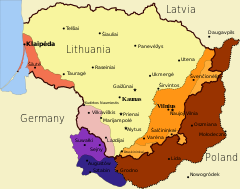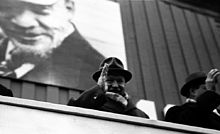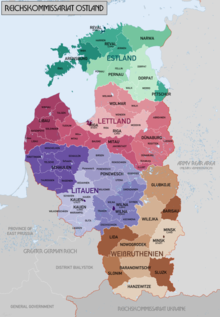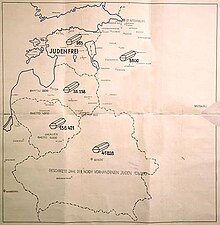German occupation of Lithuania during World War II
The military occupation of Lithuania by Nazi Germany lasted from the German invasion of the Soviet Union on June 22, 1941, to the end of the Battle of Memel on January 28, 1945.In August 1939, the Soviet Union and Nazi Germany signed the German–Soviet Nonaggression Pact and its Secret Additional Protocol, dividing Central and Eastern Europe into spheres of influence.[1] To solidify its influence, Germany suggested a German–Lithuanian military alliance against Poland and promised to return the Vilnius Region, but Lithuania held to its policy of strict neutrality.On July 1, all political, cultural, and religious organizations were closed,[11] with only the Communist Party of Lithuania and its youth branch allowed to exist.Groups of men took control of strategic objects such as railroads, bridges, communication equipment and food warehouses, protecting them from potential scorched earth tactics.The Provisional Government in Kaunas attempted to establish the proclaimed independence of Lithuania and undo the damage of the one-year Soviet regime.[citation needed] The Germans did not recognize the Lithuanian government, and at the end of July formed their own civil administration, part of the Reichskommissariat Ostland, which was divided into four Generalbezirke (General Districts).The Provisional Government resigned on August 5; some of its ministers became General Advisers (Lithuanian: generalinis tarėjas) in charge of local self-government.Overall, local self-government was quite developed in Lithuania and helped to sabotage or hinder several German initiatives, including raising a Waffen-SS unit or providing men for forced labor in Germany.[citation needed] Before the Holocaust, Lithuania was home to about 210,000[24] or 250,000[25] Jews and was one of the greatest centers of Jewish theology, philosophy, and learning which preceded even the times of the Gaon of Vilna.The Holocaust in Lithuania can be divided into three stages: mass executions (June–December 1941), ghetto period (1942 – March 1943), and final liquidation (April 1943 – July 1944).[26]: 110 The executions were carried out at three main groups: in Kaunas (Ninth Fort), in Vilnius (Ponary massacre), and in countryside (Rollkommando Hamann).[26]: 148 The surviving 43,000 Jews were concentrated in the Vilnius, Kaunas, Šiauliai, and Švenčionys Ghettos and forced to work for the benefit of German military industry.In September 1943, the United Partisan Organization led by Abba Kovner, attempted to start an uprising in the Vilna Ghetto, and later engaged in sabotage and guerrilla operations against the Nazi occupation.In 1943, several underground political groups united under the Supreme Committee for the Liberation of Lithuania (Vyriausias Lietuvos išlaisvinimo komitetas or VLIK).[37][38] In 1943, the Nazis attempted to raise a Waffen-SS division from the local population as they had in other countries, but widespread coordination between resistance groups led to a boycot.Historians attempted to quantify population losses and changes, but their task was complicated by the lack of precise and reliable data.








Occupation of theBaltic statesBaltic statesNazi GermanySoviet UnionBackgroundBaltic–Soviet relationsSoviet–EstonianSoviet–LithuanianGerman–EstonianGerman–LatvianGerman–LithuanianMolotov–Ribbentrop PactSoviet occupation in 1940Soviet-LatvianSoviet-LithuanianOrzeł incidentto Estoniato LithuaniaPeople's ParliamentSovietizationfrom Estoniafrom Latviafrom LithuaniaJune deportationWelles DeclarationGerman occupationOccupationResistanceHolocaustSoviet re-occupation in 1944Battle of NarvaBaltic offensiveCourland PocketGuerrilla war in the Baltic statesLatvian partisansLithuanian partisansUnder Soviet ruleOperation PriboiOperation JungleEstonian SSRLatvian SSRLithuanian SSRTerritorial changesBaltic WaySinging RevolutionSąjūdisTautas fronteRahvarinneCongress of EstoniaState continuityBaltic diplomatic services (1940–91)EstonianLatvianLithuanianKersten CommitteeHelsinki AccordsEstonia–Russia relationsLatvia–Russia relationsLithuania–Russia relationsRussians in EstoniaRussians in LatviaRussians in LithuaniaLithuanian JewsWehrmachtthe Holocaust in Lithuaniamilitary occupationGerman invasion of the Soviet UnionBattle of Memelrepressive Soviet regimeLithuaniaa Provisional GovernmentSoviet occupation of the Baltic states (1940)Sovietization of the Baltic statesGerman–Soviet Nonaggression Pactspheres of influenceMarch 1939 ultimatumKlaipėda RegionVilnius RegionGermany invaded PolandLublin VoivodeshipWarsaw VoivodeshipGerman–Soviet Boundary and Friendship TreatySoviet–Lithuanian Mutual Assistance TreatyVilniusSecond Polish RepublicPolish-Lithuanian WarSoviet invasion of PolandThe New York TimesWinter WarBattle of Franceanti-LithuanianPeople's SeimasLithuanian Soviet Socialist RepublicSoviet propagandaAntanas SniečkusCommunist Party of LithuanianationalizedrublescollectivizationLithuanian litasenemies of the peopleSiberiaprisoners were massacredRed ArmyOperation BarbarossaJune Uprising in LithuaniaKaunas pogromArmy Group NorthArmy Group CentreLuftwaffescorched earthKazys ŠkirpaProvisional Government of Lithuania29th Lithuanian Territorial CorpsBattle of Raseiniaianti-SovietantisemiticTautinio Darbo Apsaugos BatalionasLithuanian ArmyEinsatzkommando 3Rollkommando HamannNinth FortAlgirdas KlimaitisReichskommissariat OstlandAdrian von RentelnGeneralbezirk Litauen